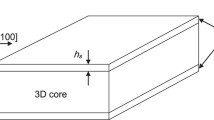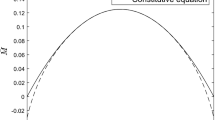Abstract
A fundamental property of solid materials is their stress state. Stress state of a solid or thin film material has profound effects on its thermodynamic stability and physical and chemical properties. The classical mechanical stress (σ M) originates from lattice strain (ɛ), following Hooke’s law: σ M=Cɛ, where C is elastic constant matrix. Recently, a new concept of quantum electronic stress (σ QE) is introduced to elucidate the extrinsic electronic effects on the stress state of solids and thin films, which follows a quantum analog of classical Hooke’s law: σ QE=Ξ(Δn), where Ξ is the deformation potential of electronic states and Δn is the variation of electron density. Here, we present mathematical derivation of both the classical and quantum Hooke’s law from density functional theory. We further discuss the physical origin of quantum electronic stress, arising purely from electronic excitation and perturbation in the absence of lattice strain (ɛ=0), and its relation to the degeneracy pressure of electrons in solid and their interaction with the lattice.
Similar content being viewed by others
References
Cammarata R C. Surface and interface stress effects in thin films. Prog Surf Sci, 1994, 46: 1–38
Ieong M, Doris B, Kedzierski J, et al. Silicon device scaling to the sub-10-nm regime. Science, 2004, 306: 2057–2060
Schäffler F. High-mobility Si and Ge structures. Semicond Sci Tech, 1997, 12: 1515
Feng J, Qian X F, Huang C W, et al. Strain-engineered artificial atom as a broad-spectrm solar energy funnel. Nat Photon, 2012, 6: 866–872
Huang M, Boone C, Roberts M, et al. Nanomechanical architecture of strained bilayer thin films: From design principles to experimental fabrication. Adv Mater, 2005, 17: 2860–2864
Yu D, Liu F. Synthesis of carbon nanotubes by rolling up patterned graphene nanoribbons using selective atomic adsorption. Nano Lett, 2007, 7: 3046–3050
Hu H, Gao H J, Liu F. Theory of directed nucleation of strained islands on patterned substrates. Phys Rev Lett, 2008, 101: 216102
Hu H, Gao H J, Liu F. Quantitative model of heterogeneous nucleation and growth of SiGe quantum dot molecules. Phys Rev Lett, 2012, 109: 106103
Sazonova V, Yaish Y, Ustunel H, et al. A tunable carbon nanotube electromechanical oscillator. Nature, 2004, 431: 284–287
Zang J, Liu F. Theory of bending of Si nanocantilevers induced by molecular adsorption: A modified Stoney formula for the calibration of nanomechanochemical sensors. Nanotechnology, 2007, 18: 405501
Khang D Y, Jiang H, Huang Y, et al. A stretchable form of single-crystal silicon for high-performance electronics on rubber substrates. Science, 2006, 311: 208–212
Hu H, Liu M, Wang Z F, et al. Quantum electronic stress: Density-functional-theory formulation and physical manifestation. Phys Rev Lett, 2012, 109: 055501
Vosko S H, Wilk L, Nusair M. Accurate spin-dependent electron liquid correlation energies for local spin density calculations: A critical analysis. Can J Phys, 1980, 58: 1200–1211
Ceperley D M, Alder B J. Ground state of the electron gas by a stochastic method. Phys Rev Lett, 1980, 45: 566–569
Hohenberg P, Kohn W. Inhomogeneous electron gas. Phys Rev, 1964, 136: B864–B871
Nielsen O H, Martin R M. First-principles calculation of stress. Phys Rev Lett, 1983, 50: 697–700
Nielsen O H, Martin R M. Quantum-mechanical theory of stress and force. Phys Rev B, 1985, 32: 3780–3791
Parr R G, Yang W T. Density functional approach to the frontier-electron theory of chemical reactivity. J Am Chem Soc, 1984, 106: 4049–4050
Madelung O, Schulz M. Numerical Data and Functional Relationships in Science and Technology, Londolt-Börnstein, Group III, New Series, Vol. 22. Berlin: Springer-Verlag, 1987
Author information
Authors and Affiliations
Corresponding author
Rights and permissions
About this article
Cite this article
Hu, H., Liu, F. Density-functional-theory formulation of classical and quantum Hooke’s law. Sci. China Technol. Sci. 57, 692–698 (2014). https://doi.org/10.1007/s11431-014-5500-x
Received:
Accepted:
Published:
Issue Date:
DOI: https://doi.org/10.1007/s11431-014-5500-x




